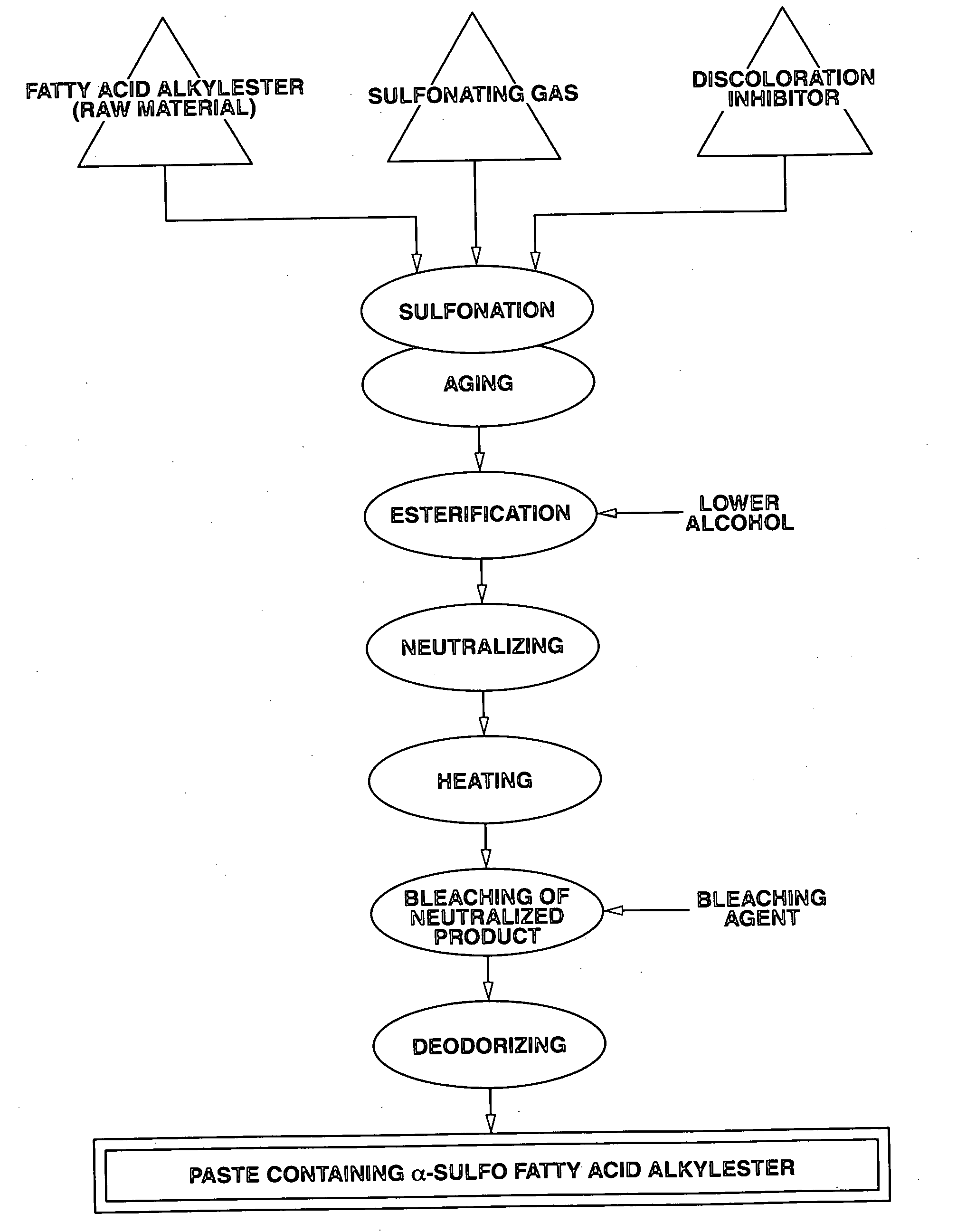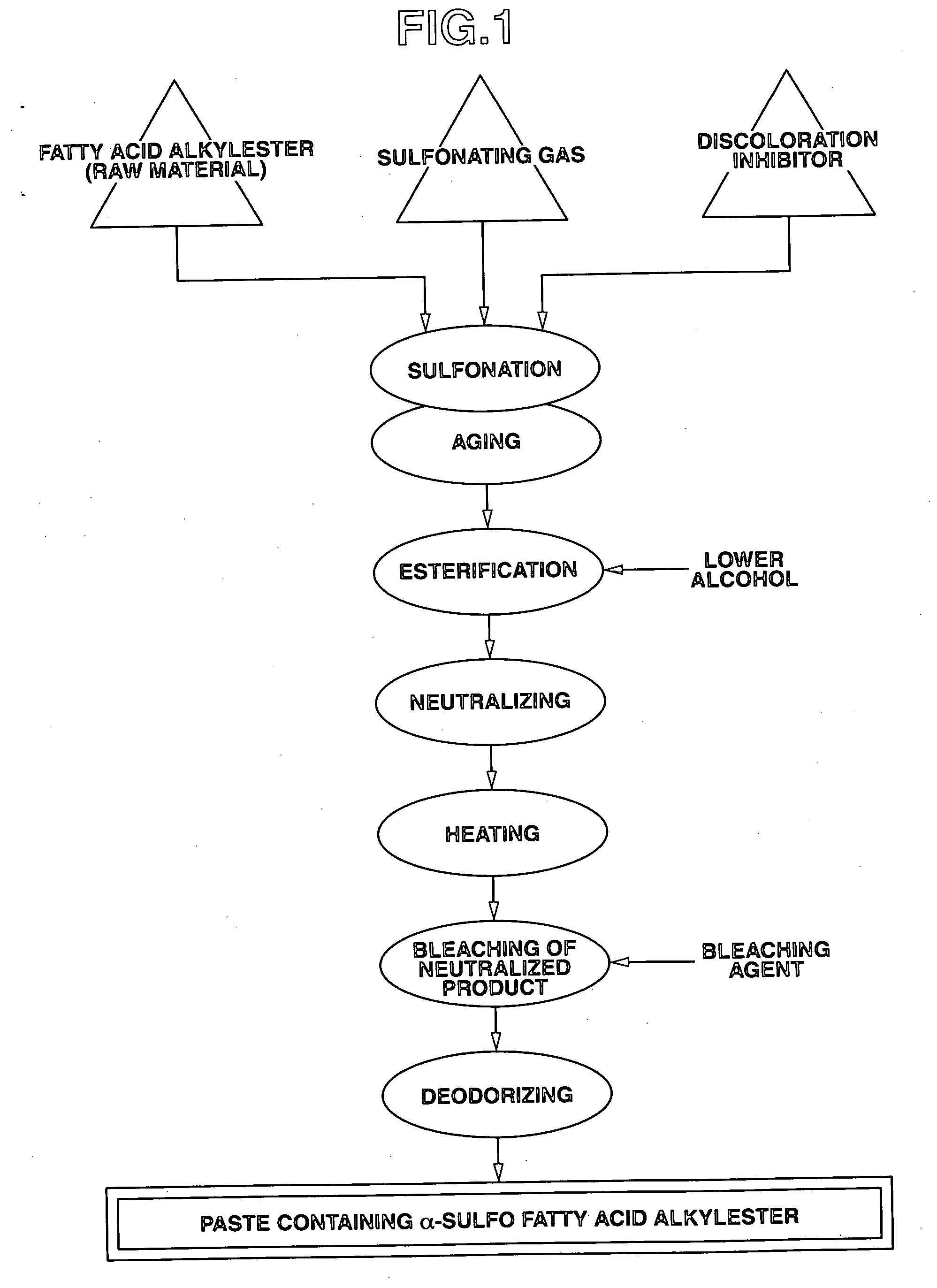Powders, flakes, or pellets containing salts of a sulfo fatty acid alkyl esters in high concentrations, process for production thereof, granulated detergents, and process for production thereof
- Summary
- Abstract
- Description
- Claims
- Application Information
AI Technical Summary
Benefits of technology
Problems solved by technology
Method used
Image
Examples
example
[0108] The invention will be described in more detail with reference to Examples and Comparative Examples, which are not intended to restrict the scope thereof. In the following example, “%” means wt % unless otherwise indicated.
[0109] The powder, flakes, pellets prepared and detergent in each example were measured for their properties by the following methods.
(1) Method for Testing the Tendency Toward Caking Under Pressure
[0110] A sample is placed in a cylindrical cell, measuring 50 mm in inside diameter and 50 mm in height. The sample is pressed under a load of 3 kg for 3 minutes at an ambient temperature of 45° C. The molded sample is removed from the cell and pressed under a load. The load required to break the molded sample is measured. The result is rated according to the following criterion.
[0111]◯: 0 to less than 3 kg
[0112]Δ: 3 to less than 4 kg
[0113] X: 4 kg or above
(2) Method for Measuring Flowability of Powder (in Terms of Repose Angle θ)
[0114] A sample is dropp...
examples 1 to 4
(1) Preparation of Paste Containing α-Sulfo Fatty Acid Alkylester Salt
(Sulfonating Step)
[0126] Sulfonation was carried out by using the reactor shown in FIG. 3. This reactor is made of SUS 316L and has a capacity of 200 L. It is equipped with the cooling jacket and the stirrer 3, so that the reaction temperature is controlled by the circulating line 7. First, the reaction vessel 1 was charged with 92 kg of fatty acid methyl ester as the raw material. Sodium sulfate (in the form of fine powder) as a discoloration inhibitor was added with thorough stirring, in an amount of 5% for the fatty acid methyl ester. With stirring continued, 110-120 m3 of SO3 gas (as a sulfonating gas) diluted to 8 vol % with nitrogen gas was introduced at a constant flow rate through the ring sparger over 1 hour. The amount of SO3 gas is equivalent to 1.2 times the amount (in mole) of the methyl ester as the raw material. During sulfonation, the reaction temperature was kept at 80° C. and the cooling medi...
examples 5 and 6
[0135] Flakes containing α-sulfo fatty acid alkylester salt in high concentrations were prepared by the same steps (1)-(3) as in Example 1. Without mixing with the inorganic powder, the flakes were fed into two sets of Fitz mill arranged in series together with cold air diluted with nitrogen such that the oxygen content was 8%. Fitz Mill is Model DKA-3 of Hosokawamicron. It has a fist-stage screen with an opening of 8 mmφ and a second-stage screen with an opening of 3.5 mmφ, and a first-stage blade rotating at 4700 rpm and a second-stage blade rotating at 2820 rpm. The flow rate was 6 Nm3 / min. Crushing was carried out at a throughput of 150 kg / hr. The resulting crushed product (powder) underwent the second aging step under the condition shown in Table 1. Thus there was obtained a powder containing α-sulfo fatty acid alkylester salt. The properties of the powder are shown in Table 1.
[0136] In the following, “according to the method of the specific example” means that it should be a ...
PUM
| Property | Measurement | Unit |
|---|---|---|
| Length | aaaaa | aaaaa |
| Particle diameter | aaaaa | aaaaa |
| Concentration | aaaaa | aaaaa |
Abstract
Description
Claims
Application Information
 Login to View More
Login to View More - R&D
- Intellectual Property
- Life Sciences
- Materials
- Tech Scout
- Unparalleled Data Quality
- Higher Quality Content
- 60% Fewer Hallucinations
Browse by: Latest US Patents, China's latest patents, Technical Efficacy Thesaurus, Application Domain, Technology Topic, Popular Technical Reports.
© 2025 PatSnap. All rights reserved.Legal|Privacy policy|Modern Slavery Act Transparency Statement|Sitemap|About US| Contact US: help@patsnap.com



